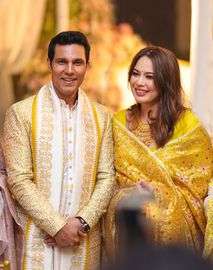The talented actor and eligible bachelor Randeep Hooda married his girlfriend Lin Laishram last week. All eyes were on the new couple, since we all love happy endings. Moreover, handsome Hooda has always had a large female following, ever since his debut Monsoon Wedding (2001), bolstered by his excellent roster of performances. And, of course, his much photographed relationship with Sushmita Sen.
Hooda’s wedding with model and actor Laishram was especially notable as the actor married his bride in a traditional Manipuri-style wedding. Laishram is from the dominant Hindu Meitei tribe of Manipur. Manipur has in fact dominated the political narrative all of last year for the ongoing ethnic violence between the Meiteis of the Imphal valley and the smaller Kuki-Zo tribes of the mountains.
I must apologise for the ethno-centrism, but Laishram and Hooda looked like two dolls that one sees in museums or craft emporia that showcase India’s many states and their communities. Perhaps the biggest problem is that we assume weddings to be north Indian weddings only. The bride wears red and waits, the groom’s family comes in dancing raucously, the ‘milni’ ceremony or exchange of garlands, and the circles around the holy fire. Of course, we blame the Punjabi-dominated Bollywood for this. But ostentation in cinema is so attractive and escapist for all of us.
In fact, the depiction of a simple Buddhist-style wedding in a Neeraj Ghaywan-directed episode of Made in Heaven 2 was universally touted to be the favourite of all weddings. An upper caste groom marrying his ‘dalit’ girlfriend in a Buddhist wedding and acknowledging her roots—which her community has historically kept hidden—was a major step towards inter-caste inclusivity.
Hooda and Laishram had a small wedding at the bride’s hometown; the groom said he wanted to show respect to his wife’s community and traditions. It is also a north Indian custom for the groom to go to the bride’s village to bring her back to his. The ‘reception’ is when the bride has been ‘received’. The Meitei wedding was as magical and poetic as it was exotic to the rest of India.
Hinduism among the Meiteis is hugely influenced by Bengali Vaishnavism, according to which Krishna is the supreme deity and not an incarnation of Vishnu. He is also in eternal play, or leela, with Radha. The Meitei bride and groom, like the Bengali Vaishnavs, are dressed like Radha and Krishna, and not like the north Indian king and queen (Ram and Sita).
The bride wears a cylindrical skirt called a ‘potloi’ that is sewn on her just minutes before the wedding. The skeleton is made of bamboo, and the cloth is the traditional handwoven textile. Manipuri textiles are associated with rituals and social events, especially since they played an additional economic role for the agriculturalists. Textiles decentralised social and economic power and gave employment to people. For Meiteis, the weaving of textile is a cosmic process which symbolises the dance of creation. According to the Meiteis, man learned weaving through his own enterprise and intelligence, by watching a spider weave a web. It is another matter that almost all the weaving in Manipur is a female activity.
Laishram’s potloi comes with a blouse and a woven belt. A muslin shawl is famously called the ‘innaphi’. The gold ornaments symbolising Radha are called the ‘jhapa’. While the Indian wedding industry is pegged at nearly 04 lakh crore, it is especially heartwarming to see customs and ceremonies that cost little, but warm the heart so much more.


